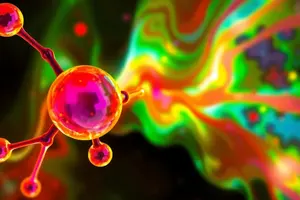Podcast
Questions and Answers
What are the two primary types of vibrational modes in molecules?
What are the two primary types of vibrational modes in molecules?
The two primary types of vibrational modes are stretching vibrations and bending vibrations.
Explain the difference between symmetric and asymmetric stretching vibrations.
Explain the difference between symmetric and asymmetric stretching vibrations.
Symmetric stretching involves both bonds changing length in the same direction, while asymmetric stretching occurs when one bond lengthens and the other shortens.
What role does infrared (IR) spectroscopy play in studying molecular vibrations?
What role does infrared (IR) spectroscopy play in studying molecular vibrations?
IR spectroscopy measures the absorption of infrared light, which causes transitions between different vibrational states of a molecule.
Describe the harmonic oscillator model in the context of molecular vibrations.
Describe the harmonic oscillator model in the context of molecular vibrations.
How does Raman spectroscopy differ from infrared spectroscopy?
How does Raman spectroscopy differ from infrared spectroscopy?
What are the key characteristics of bending vibrations?
What are the key characteristics of bending vibrations?
Why are the vibrational modes of a molecule significant in vibrational spectroscopy?
Why are the vibrational modes of a molecule significant in vibrational spectroscopy?
What is the relationship between molecular structure and vibrational modes?
What is the relationship between molecular structure and vibrational modes?
What is the expression for the vibrational energy levels of a harmonic oscillator?
What is the expression for the vibrational energy levels of a harmonic oscillator?
How do the vibrational energy levels of an anharmonic oscillator differ from those of a harmonic oscillator?
How do the vibrational energy levels of an anharmonic oscillator differ from those of a harmonic oscillator?
What is the significance of the selection rule $,∆v = ±1$ in vibrational spectroscopy?
What is the significance of the selection rule $,∆v = ±1$ in vibrational spectroscopy?
Describe the role of the Morse potential in modeling molecular vibrations.
Describe the role of the Morse potential in modeling molecular vibrations.
In what ways is vibrational spectroscopy utilized in structural elucidation?
In what ways is vibrational spectroscopy utilized in structural elucidation?
How does Raman spectroscopy differ from IR spectroscopy in terms of selection rules?
How does Raman spectroscopy differ from IR spectroscopy in terms of selection rules?
What types of materials can be studied using Raman spectroscopy?
What types of materials can be studied using Raman spectroscopy?
What is the importance of vibrational spectroscopy in the biological sciences?
What is the importance of vibrational spectroscopy in the biological sciences?
Flashcards
Vibrational Spectroscopy
Vibrational Spectroscopy
A technique used to study molecular vibrations, providing insights into structure, dynamics, and interactions.
Molecular Vibrations
Molecular Vibrations
Periodic motions of atoms within a molecule around their equilibrium positions.
Stretching Vibrations
Stretching Vibrations
Vibrational modes involving changes in bond lengths between atoms.
Bending Vibrations
Bending Vibrations
Signup and view all the flashcards
Infrared (IR) Spectroscopy
Infrared (IR) Spectroscopy
Signup and view all the flashcards
Raman Spectroscopy
Raman Spectroscopy
Signup and view all the flashcards
Harmonic Oscillator Model
Harmonic Oscillator Model
Signup and view all the flashcards
Vibrational Modes
Vibrational Modes
Signup and view all the flashcards
Harmonic Oscillator
Harmonic Oscillator
Signup and view all the flashcards
Anharmonic Oscillator
Anharmonic Oscillator
Signup and view all the flashcards
Morse Potential
Morse Potential
Signup and view all the flashcards
Vibrational Quantum Number (v)
Vibrational Quantum Number (v)
Signup and view all the flashcards
IR Active Vibrational Transition
IR Active Vibrational Transition
Signup and view all the flashcards
Selection Rule (∆v)
Selection Rule (∆v)
Signup and view all the flashcards
Raman Spectroscopy
Raman Spectroscopy
Signup and view all the flashcards
Vibrational Spectroscopy Applications
Vibrational Spectroscopy Applications
Signup and view all the flashcards
Study Notes
Introduction to Vibrational Spectroscopy
- Vibrational spectroscopy is a powerful analytical technique for studying molecular structure, dynamics, and interactions.
- It provides detailed information about molecular vibrations.
- This method covers fundamental principles, mathematical foundations, and key applications.
Principles of Vibrational Spectroscopy
- Molecular Vibrations: Molecules are dynamic, atoms vibrating around equilibrium positions.
- Vibrational Modes: Types of vibration depend on molecular structure and atoms involved.
- Stretching vibrations: Changes in bond lengths (symmetric or asymmetric).
- Bending vibrations: Changes in bond angles (scissoring, rocking, wagging, twisting).
Infrared (IR) Spectroscopy
- IR spectroscopy measures absorption of infrared light by molecules.
- This causes transitions between vibrational states.
- IR spectra provide a "fingerprint" of the molecule, with each peak corresponding to a specific vibrational mode.
Raman Spectroscopy
- Raman spectroscopy is based on inelastic scattering of light (Raman scattering).
- Most scattered light is elastic (Rayleigh scattering).
- A small fraction is inelastic, shifting energy which corresponds to vibrational modes.
Mathematical Foundations
- Harmonic Oscillator Model: A simplified model for molecular vibrations.
- Potential energy V(x) is calculated using kx2/2, where x is displacement from equilibrium, and k is a force constant
- Vibrational energy levels (Ev) are calculated using (v + 1/2)ħω, where v is the vibrational quantum number, ħ is reduced Planck's constant, and ω is angular frequency of vibration.
- Anharmonic Oscillator Model: Accounts for deviations from perfect harmonic behavior in real molecules.
- Morse potential (V(x)) approximates potential energy more accurately than the harmonic oscillator.
- Variables include De (dissociation energy), a (constant related to potential well width), and xe (equilibrium bond length).
- Anharmonic energy levels (Ev) are more complex than harmonic levels, including factors for anharmonicity (χe).
- Morse potential (V(x)) approximates potential energy more accurately than the harmonic oscillator.
Applications of Vibrational Spectroscopy
- Structural Elucidation: Used to determine molecular structure by analyzing IR and Raman spectra.
- Identifying functional groups and characterizing molecular geometry.
- Chemical Analysis: Used for identifying and quantifying chemical compounds (e.g., pharmaceuticals, environmental science, food industry).
- Material Science: Studies materials like polymers, nanomaterials, and semiconductors, examining crystallinity, phase transitions, and molecular interactions
- Biological Systems: Studies biological molecules (proteins, nucleic acids, lipids) to determine structure, dynamics, and interactions.
- Environmental Monitoring: Monitors atmospheric gases and pollutants using IR spectroscopy.
Studying That Suits You
Use AI to generate personalized quizzes and flashcards to suit your learning preferences.




